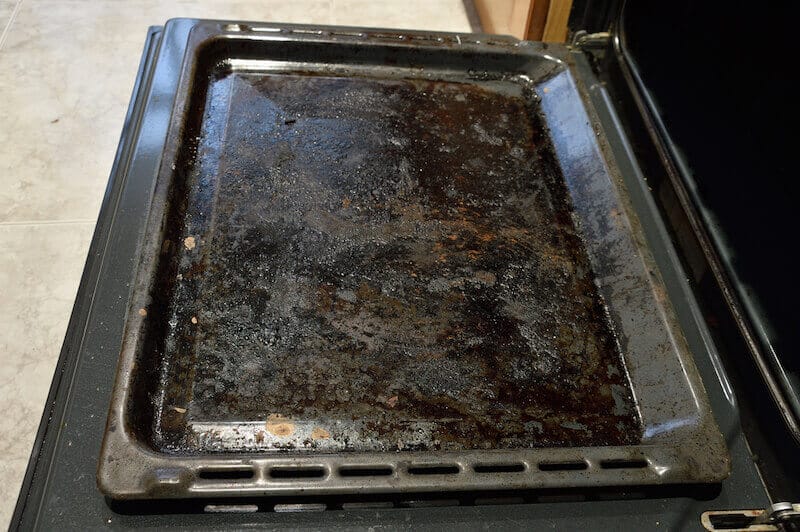The oven is a powerhouse in your kitchen, able to cook everything from delicious cookies to full meals.
While the oven and racks build up dirt over time, it’s the oven trays that take the brunt of the food gunk. Stuck-on food, grease splatters, burnt sauces… those pans go through a lot!
A warped or grease-caked oven tray may need replacing, but sometimes all it needs is some TLC and it’s (almost) as good as new.
How to clean oven trays? Our top methods include:
- Dish soap
- Dishwasher tablets
- Baking soda
- White vinegar
- Soda crystals
- Oven cleaner
- Bar Keepers Friend
Don’t toss out that baking sheet just yet! Grab your supplies and get ready to (c)rumble.
What IS an Oven Tray, Anyway?
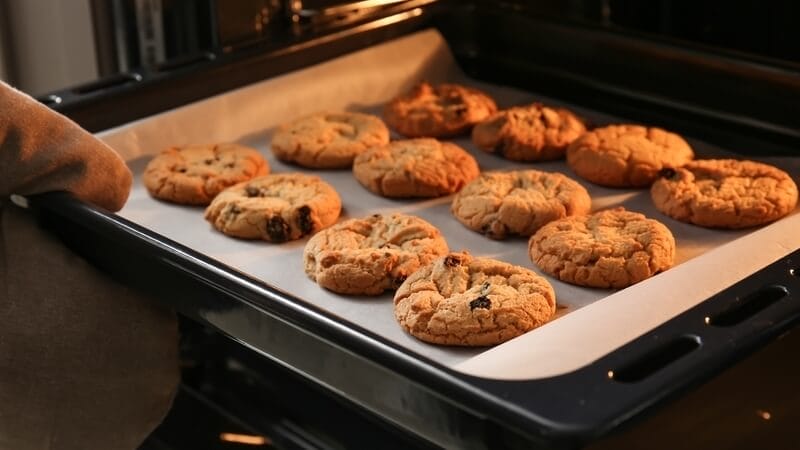
An oven tray is any sheet used to cook in the oven. It’s called a lot of different things – baking trays, baking sheets, oven pans, sheet pans – but these all have the same function: to hold food while it cooks.
Oven racks, on the other hand, are metal grilles that act as “shelves” in the oven. You’ll typically put a tray on top of the rack when cooking or baking.
It’s important you clean oven pans and trays as it minimises the build-up of grease, stuck-on food, and other debris. Otherwise, you’ll risk the debris developing mould – or worse, becoming a fire hazard.
(Don’t forget to clean the rest of the oven, too!)
Types of Oven Trays
Oven or baking trays come in many different shapes, sizes, and materials.
The type of material helps determine what you use the pan for and how you clean it.
Aluminium trays: This is a popular material for oven baking trays, including cookie sheets. Aluminium is a versatile material as it’s lightweight and distributes heat evenly. Most aluminium baking trays are NOT non-stick, however, so they can be tricky to clean.
Non-stick baking trays: These are made of metal covered with a non-stick coating, usually Teflon or titanium-ceramic. The coating prevents any food from sticking to the pan despite the high heat, and makes the trays easier to clean.
Enamel trays: Instead of Teflon, these pans have a porcelain-enamel coating, much like stove grates. The coating isn’t fully non-stick, but has excellent heat transfer and stain resistance. It’s easiest to clean enamel oven trays with baking soda.
Glass pans: These are more old-school, and are best for low-temperature baking. Glass takes longer to heat up but retains that heat for longer, so you can serve baked dishes directly in the glass pan. The material is also naturally non-stick and easy to clean, but make sure it’s shatter-proof!
Silicone moulds: This is a less common material, and is more used for baking moulds or other funky shapes. Food-grade silicone can usually tolerate heat up to 220ºC (428ºF), but will be “floppier” or less rigid than other types of trays and will need a supporting sheet underneath.
How Often to Clean Oven Trays
Ideally, you should wash oven trays after every use. This lets you clean up any grease, food debris, and other dirt immediately so they don’t stick to the tray and become harder to remove later on.
However, if you’ve used lining paper or similar protective layers, you can get away with wiping the tray down, then deep cleaning once a week.
Before cleaning an oven tray
Check the manufacturer’s instructions or label to see if there are any products you shouldn’t use on your oven tray.
For example, abrasive cleaners like scouring pads can damage non-stick pans, so opt for soft sponges and microfibre cloths.
If you’re unsure, you can test the cleaning method on an inconspicuous spot first. Watch for any discolouration, scuffing, or other damage.
Before cleaning oven trays, remove excess grease and loose food debris with some paper towels. This will make the trays or pans easier to clean.
Best Ways to Clean Oven Trays
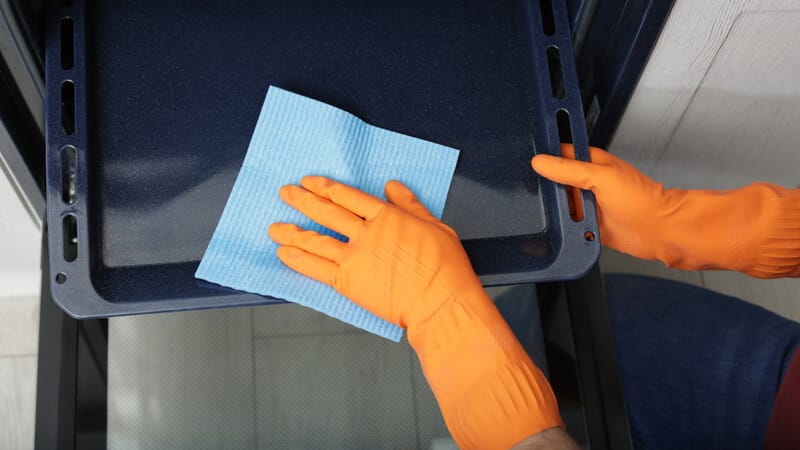
Now – how to clean oven trays? There are several methods to use, depending on how dirty or burnt the trays are, and what you have on hand.
Of course, if those dirty oven trays look daunting, you can always add them on when you hire a professional house cleaning service for oven cleaning – alongside the rest of the kitchen!
Using dish soap
This is the easiest method for cleaning a baking tray, but it works best for light or everyday washing.
Fill up the bathtub or sink with hot water, then add a little dishwashing liquid. (Regular dish soap is fine, but anti-grease formula adds some extra oomph.)
Soak the trays in the hot, soapy water for 30-60 minutes to loosen any grease and grime. Then take a non-abrasive sponge or cleaning pad (like these Scotch-Brite Cooktop Pads) to scrub the pans clean.
Rinse them off, then dry them with a clean cloth.
NOTE: This method works for any baking tray, but be sure you use non-abrasive sponges for non-stick baking trays. Abrasive cleaners may scratch the delicate finish.
Using a dishwasher tablet
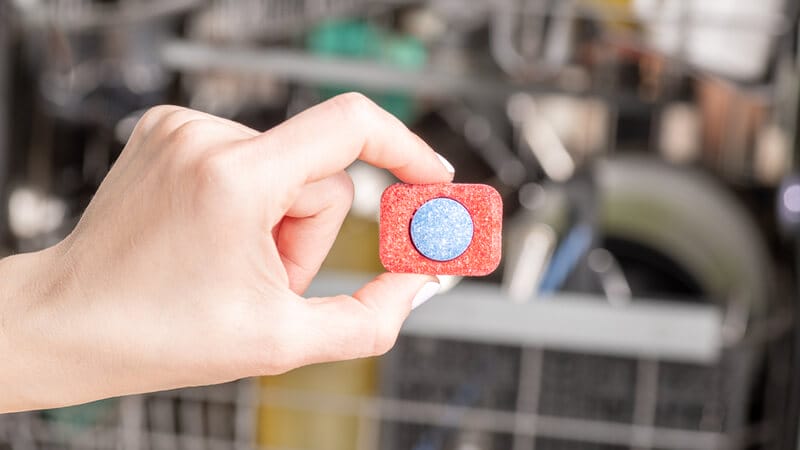
There are two variations to this oven tray cleaning hack! The first method is similar to the dish soap method, and works best for a non-stick baking tray.
Place the tray in the sink or tub, then place a dishwasher tablet in the middle. You can use any type of tablet, such as Finish Classic Everyday Clean Tablets or the plant-based EcoStore Dish Tabs.
Pour hot water carefully into the pans or sheets until you’ve covered the whole bottom surface. The tablet will dissolve in the heat, and the cleaning solution will loosen grease and food debris.
Leave until the water cools, then scrub the pan with a non-abrasive sponge. Rinse clean.
For aluminium trays (such as a roasting tray), you can use a hack similar to oven cleaning with a tablet. Dip a pressed-powder dishwasher tablet in some warm water, just enough to dampen the surface.
Hold the tablet flat and use it to scrub the surface of the tray. This will take some elbow grease, but it uses fewer supplies and you can easily rinse the trays clean afterwards.
Using baking soda
You can use this for most types of baking trays and pans, since baking soda is only mildly abrasive. It’s your best method to clean enamel oven trays.
Place the trays in a sink or bathtub, then sprinkle baking soda over the bottom surface. Carefully pour boiling water into the pan (or hot water with some dish soap).
Let the trays sit for at least an hour, then wipe off the grease and debris with a clean microfibre cloth. Wash off any residue with soap and water, then dry.
Alternatively, soak the trays in a sink with hot water and half a cup of vinegar. After 30-60 minutes, take them out and sprinkle on some baking soda.
Use a soft sponge to scrub any grease and food off the pan, then wash off the residue with soap and water. Dry with a soft cloth.
Using white vinegar
Surprisingly, this trick combines white vinegar with cream of tartar!
This will take quite some time (you may have to leave your trays sitting overnight), but it does cut down on the effort in scrubbing.
Sprinkle cream of tartar all over the baking tray, then spritz with vinegar poured into a spray bottle. Make sure the whole surface is saturated, then let the trays sit for at least 8 hours (or even overnight).
For aluminium trays, use a scrubby sponge or scouring pad to scrub off grease, food debris, and grime. For non-stick pans, use a non-abrasive sponge or pad.
Wash quickly with soap and water, then dry.
Using soda crystals
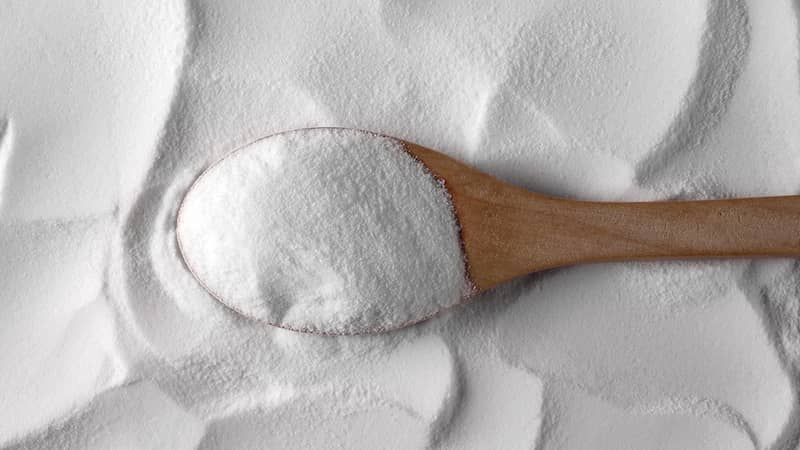
This is one of the more old-school cleaning methods. Soda crystals are sodium carbonate – you may know them more as washing soda!
This method is most effective immediately after you’ve used the oven tray, while the grease and food debris haven’t dried.
Sprinkle the washing soda over the tray, enough to cover the dirty areas. Let that sit for up to 30 minutes so the crystals can soak up any excess grease.
Use a soft cloth or paper towel to wipe off the greasy washing soda, and toss it in the bin. Paper towels might be easier for this, since you can toss them directly into the rubbish.
Wash the trays with dishwashing liquid and water to remove any residue, then dry.
NOTE: Washing soda is not the same as washing powder!
Using oven cleaner
Always test this method on an inconspicuous spot first to make sure the oven cleaner won’t damage the tray. Moreover, if you want to avoid harsh chemicals, opt for one of the previous methods instead.
Do not use this method on non-stick trays.
As most oven cleaners (such as Easy-Off Heavy Duty Oven Cleaner) are spray types, it’s best to work outdoors or in a well-ventilated room. Wear rubber gloves, a face mask, and eye protection!
Place the baking tray inside a large garbage bag, then spray it with your chosen oven cleaner. Tie the bag shut and let it sit for up to 30 minutes.
Once time is up, use a scrubby pad to work off any grease and grime. Wash the tray thoroughly with hot, soapy water to remove any residue, then wipe it dry.
Using Bar Keepers Friend
This method also works to clean an oven rack! Make sure to use Bar Keepers Friend Powder Cleanser, as it’s safe to use on cookware.
(Still, test the cleanser on an inconspicuous spot first to make sure it doesn’t cause any damage.)
Opt for this trick for particularly stubborn grime, or if you don’t want to spend too much time scrubbing.
Make a slightly thick paste with Bar Keepers Friend powder and some warm water. Use a soft sponge to apply the paste to the tray, then let it sit for up to 45 minutes.
Wash the tray thoroughly in hot, soapy water to remove any residue. Dry the tray with a microfibre cloth.
How to Clean Burnt Oven Trays
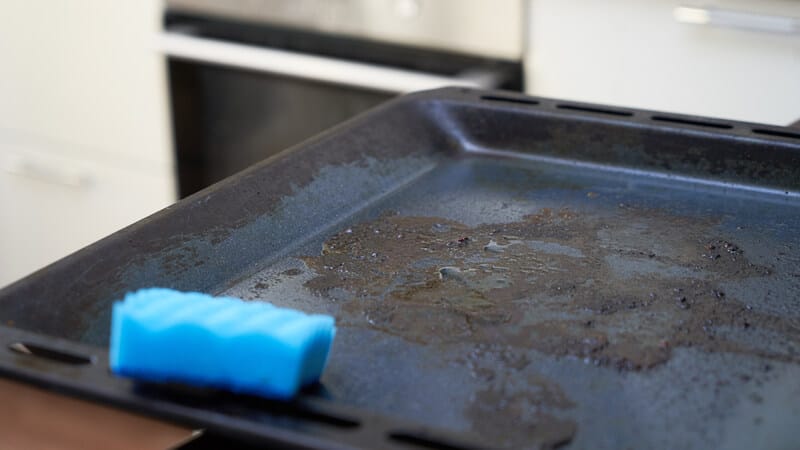
For burnt-on food, baked-on grease, and other burn marks, baking soda works great! Plus, you can use this to clean burnt non-stick oven trays as bicarbonate of soda is only mildly abrasive.
Make a paste out of baking soda, hot water, and a few drops of dishwashing liquid. Apply it to your oven tray with a sponge or cleaning pad, then let it sit for a few hours.
Use the sponge or pad to scrub the burnt-on food or grease off the tray, working in a circular motion. Rinse with water, then repeat until all the burn marks or debris are removed.
NOTE: You can try this method to remove rust from oven trays! Soak the tray in hot water and vinegar beforehand, then give it a good scrub with the paste.
Can You Use the Self-Cleaning Function on Oven Trays?
If the manufacturer’s manual or instructions say the self-cleaning function can work on oven pans or trays, then yes, you can use it.
However, this is generally not recommended – the high heat can warp the trays or cause other damage. An oven’s self-cleaning function is also a fire risk.
FAQS about Cleaning Oven Trays
Here are some answers to common questions and concerns about how to clean oven trays.
Can you clean baking trays with oven cleaner?
Yes – but only the aluminium ones! Do not use oven cleaner on non-stick, glass, enamel, and silicone trays.
Test the oven cleaner first to make sure it doesn’t cause any damage.
Does vinegar clean baking trays?
Yes, but not on its own. Vinegar is best combined with other cleaning agents like cream of tartar or dish soap for the most cleaning power.
Avoid using vinegar to clean enamel oven trays as it could etch the finish.
Can you clean oven trays with washing powder?
Technically yes, but if you’re particularly conscious of what you use on items that touch food, you may want to avoid it! (Or use a biological washing powder.)
Washing powder is a detergent and is not formulated for cookware.
Can you clean baking sheets with hydrogen peroxide?
One suggested method for cleaning dirty oven trays involves pouring a cup of baking soda onto the oven tray, then spritzing it with hydrogen peroxide.
You then let the cleaning solution sit for up to two hours before washing the tray thoroughly with dish soap and water.
However, hydrogen peroxide is not food-safe and may bleach or degrade the baking trays. Test this method on a tiny spot first if you want to use it.

